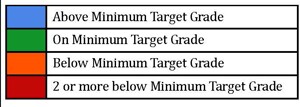- Home
- Curriculum
- Reporting and Assessment
Reporting and Assessment
Reporting and Assessment 2022-2023
Assessment can be seen as the bridge between teaching and learning. Dylan Wiliam describes this well:
“It is only through assessment that we can find out whether what has happened in the classroom has produced the learning we intended.”
Our approach to Assessment has two layers:
- Formative – on-going, ungraded and focused on smaller chunks of the curriculum
- Summative – at set points in the year. Knowledge included will build cumulatively
through the year
Marking and Feedback
Departments develop their own policy using a tight but loose approach. Tight in that they must adhere to the principles but loose in that they tailor assessment, marking and feedback to their subject domain.
1. Feedback should be used to identify the ‘learning gaps’ of individual students.
2. Feedback should be specific and clearly focused on learning goals – with a view to moving on the learning of individual students.
3. It should also focus on what students achieve and take pride in – so they continue to do so.
4. Students must be able to, and expected to, respond to the feedback, so they can work towards closing the learning gap.
5. Feedback can take a variety of forms – teacher to student; student to teacher; student to student; written and verbal; focused on classwork, homework and assessments. All are equally valid.
6. Different forms of feedback will be more appropriate for different subjects. Subject areas will agree and decide on how feedback is consistently used across the subject.
7. Feedback is not an add on. It is an ongoing and essential part of excellent pedagogy, used to deepen learning and improve teaching.
8. Feedback should be challenging – and used to encourage students to aspire to excellence.
9. Feedback should be high impact but manageable and sustainable and used to inform planning and teaching
10. Students should receive a minimum of two bits of formal teacher feedback per term.
Reporting
Reports are sent to parents/carers (week beginning) via the Edulink App
| Year | Term 1 | Term 2 | Term 3 | Term 4 | Term 5 | Term 6 |
|---|---|---|---|---|---|---|
| 7 | 9th Feb | 18th May | ||||
| 8 | 24th Nov | 27th April | 6th July | |||
| 9 | 8th Dec | 27th April | 6th July | |||
| 10 | 24th Nov | 9th Feb | 13th July | |||
| 11 | 1st Dec | 16th Mar | ||||
| 12 | 8th Dec | 9th Mar | 15th June | |||
| 13 | 13th Oct | 9th Feb |
In addition to their reports, all students will receive a grade for one of the 3 areas below:
| Attitude to Learning | Exemplary |
I have an outstanding attitude to learning, work consistently hard, challenge myself and respond well to feedback |
|---|---|---|
| Good | I have a good attitude to learning, work hard and respond well to feedback | |
| Inconsistent | My attitude to learning requires some improvement as I sometimes get distracted and so cannot focus on my work | |
| Concerning | My attitude to learning is concerning as I am often off task and distract others |
| Homewood Habits | Exemplary | I take pride in my work and challenge myself in lessons. I arrive on time, listen carefully to instructions and I am fully equipped for lessons |
|---|---|---|
| Good | My work is presented neatly most of the time. I arrive on time to the vast majority of my lessons and bring most of my equipment to school with me | |
| Inconsistent | There is a lack of pride in some of my work as I do not bring the correct equipment to school. Some of my work suffers as I do not listen to instructions | |
| Concerning | My work is presented poorly with little care and attention to detail due to a lack of basic equipment. My listening skills need to improve so that I can progress with my work |
| Home Learning | Exemplary | All of my homework is handed in on time and completed to a high standard |
|---|---|---|
| Good | Most of my homework is handed in on time and completed to a good standard | |
| Inconsistent | Some of my homework is handed in late and completed to an adequate standard | |
| Concerning | Most of my homework is handed in late and completed to a poor standard |
Year 7, 8 and 9 Academic Reports
Year 7, 8 and 9 Academic Reports contain the following information:
| Minimum Target Grade |
Based on Key Stage 2 attainment, this is the target that your child is capable of achieving. In Years 7-9, students have one of the 3 target grades:
|
|---|---|
| Average Unit Grade |
This is the average attainment that your child is currently achieving in each of their subjects. These will be one of the following:
Please note, this will be blank if your child was absent from their assessments and there will also be only 2 Learning Characteristics for PE. If your child is working at their expected rate, their Average Unit Grade will be the same as their Minimum Target Grade. The following colour coding is used to show progress:
|
Year 10 and 11 Reports
Year 10 and 11 Academic Reports
| Minimum Target Grade |
Based on Key Stage 2 attainment, this is the target that your child is capable of achieving at the end of Year 11 |
|---|---|
|
Teacher Predicted Grade |
This is the current grade prediction that a student is likely to achieve based on their current levels of effort and attainment |
| Qualification | Marks Awarded | Explanation |
|---|---|---|
|
GCSE |
U 1-9 |
Grade 4 is a standard pass / Grade 5 is a good pass |
|
BTEC |
U P1 / M1 / D1 P / P2 M / M2 D / D2 D* / D2* |
Students will obtain either a: Level 1 pass. This will show as a P1 (Level 1 Pass), M1 (Level 1 Merit), D1 (Level 1 Distinction) or a Level 2 pass. This will show as P or P2 (Level 2 Pass), M or M2 (Level 2 Merit) D or D2 (Level 2 Distinction) and D* or D2* (Level 2 Distinction) Level 1 - Equivalent to Foundation level GCSE (grades 1-3) Level 2 - GCSE equivalent (grades 4+) |
Year 12 and 13 Reports
Year 12 and 13 Academic Reports
| Minimum Target Grade |
This is the target grade we expect your child to obtain in each subject. This will either be
|
|---|---|
| Teacher Predicted Grade |
This is the final grade your child’s teacher expects them to obtain at the end of Year 13, if they continue their current rate of progress. |


